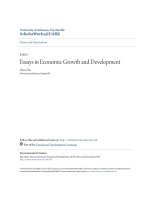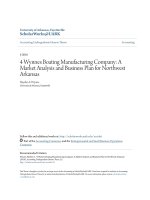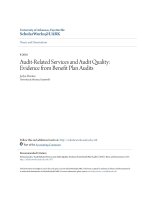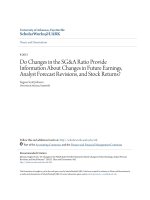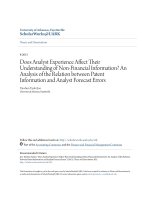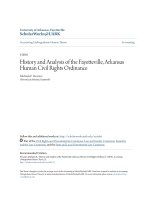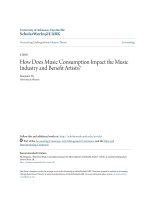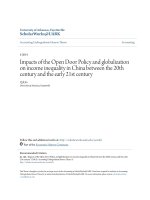Accounting undergraduate Honors theses: Audit related services and audit quality - Evidence from benefit plan audits
Bạn đang xem bản rút gọn của tài liệu. Xem và tải ngay bản đầy đủ của tài liệu tại đây (469.8 KB, 104 trang )
University of Arkansas, Fayetteville
ScholarWorks@UARK
Theses and Dissertations
8-2016
Audit-Related Services and Audit Quality:
Evidence from Benefit Plan Audits
Jaclyn Prentice
University of Arkansas, Fayetteville
Follow this and additional works at: />Part of the Accounting Commons
Recommended Citation
Prentice, Jaclyn, "Audit-Related Services and Audit Quality: Evidence from Benefit Plan Audits" (2016). Theses and Dissertations. 1671.
/>
This Dissertation is brought to you for free and open access by ScholarWorks@UARK. It has been accepted for inclusion in Theses and Dissertations by
an authorized administrator of ScholarWorks@UARK. For more information, please contact ,
Audit-Related Services and Audit Quality: Evidence from Benefit Plan Audits
A dissertation submitted in partial fulfillment
of the requirements for the degree of
Doctor of Philosophy in Business Administration
by
Jaclyn Prentice
Southeastern Oklahoma State University
Bachelor of Business Administration in Accounting, 2004
Southeastern Oklahoma State University
Bachelor of Science in Mathematics, 2004
University of Texas at Dallas
Master of Science in Accounting Information Management, 2012
August 2016
University of Arkansas
This dissertation is approved for recommendation to the Graduate Council.
Dr. Gary F. Peters
Dissertation Director
Dr. Ken Bills
Committee Member
Dr. Jonathan Shipman
Committee Member
ABSTRACT
The following study examines a material but less understood component of the public
audit marketplace, namely the provision of “audit-related” services to financial statement audit
clients. I use the benefit plan audit service setting to examine the company and benefit plan
characteristics associated with auditor selection and the impact of audit-related services on
financial statement audit quality. I provide market evidence of distinct shifts in the use of the
same audit firm for the financial statement audit and other audit-related services over time as
well as characteristics of the choice of auditors. I then test whether having the same audit firm
for both types of audit services is associated with financial statement audit quality as measured
by missed misstatements (revealed through future restatements). I find that companies that
engage the same audit firm for their financial statement audit and benefit plan audit are less
likely to have subsequent restatements. I also test whether having the same audit firm for both
types of audit services is associated with switching the financial statement audit firm. I find that
companies that engage the same audit firm for their financial statement audit and benefit plan
audit are associated with a lower likelihood of switching their financial statement audit firm.
Overall, my results suggest that choosing the same auditor for both the financial
statement audit and audit-related services is associated with a higher level of financial statement
audit quality consistent with knowledge spillover between the financial statement and benefit
plan audits. My findings also suggests that who provides audit-related services, and whether or
not that provider has changed, affects the perception of switching costs for the financial
statement audit.
Acknowledgments
I am grateful for the support and guidance of my dissertation committee: Gary Peters
(chair), Ken Bills, and Jonathan Shipman. I would also thank workshop participants at the
University of Arkansas, the University of North Dakota, and Oklahoma State University for
helpful suggestions and comments. I thank Burch Kealey at the University of Nebraska for his
assistance with Direct Edgar, a helpful tool in hand collecting information. I thank my family for
their encouragement. I thank my husband, David, for his support in accomplishing my goals and
dreams.
Dedication
I dedicate this dissertation to my wonderful husband, David Prentice. He has encouraged
and supported me. I love him always and forever.
TABLE OF CONTENTS
I. INTRODUCTION .....................................................................................................................1
II. BACKGROUND, PRIOR LITERATURE, AND HYPOTHESES DEVELOPMENT ............6
Benefit Plan Audits ..............................................................................................................6
Benefit Plan Audit Complexity ............................................................................................8
Increased Services and Monitoring ....................................................................................10
Benefit Plan Industry Specialist .........................................................................................11
Audit Quality and Audit-Related Services ........................................................................12
The Changing Provision of Audit-Related Services ..........................................................15
Company, Audit, and Benefit Plan Characteristics ..........................................................16
The Benefit of Benefit Plans? ............................................................................................18
Auditor Switching ..............................................................................................................21
III. SAMPLE SELECTION, DATA COLLECTION, AND DESCRIPTIVES ............................23
Sample Selection and Data Collection ...............................................................................23
Descriptive Statistics..........................................................................................................26
IV. RESEARCH DESIGNS ...........................................................................................................28
Characteristics of Having the Same Auditor ....................................................................28
Audit Quality ....................................................................................................................34
Benefit Plan Audit Quality and Benefit Plan Quality ......................................................38
Characteristics of Switching Benefit Plan Auditors .........................................................43
Switching the Financial Statement Auditor ......................................................................44
V. RESULTS ................................................................................................................................46
Characteristics of the Same Audit Firm Providing Audit and Audit-Related Services ...46
Audit Knowledge Spillover – Benefit Plan Audit to the Financial Statement Audit .......48
Audit Knowledge Spillover – Financial Statement Audit to the Benefit Plan Audit .......51
Benefit Plan Auditor Switching........................................................................................52
Financial Statement Auditor Switching ...........................................................................53
VI. CONCLUSION ........................................................................................................................54
REFERENCES ..............................................................................................................................57
APPENDIX A: Variable Definitions ............................................................................................62
LIST OF TABLES
1. Sample Selection
Panel A – Number of Observations .........................................................................................67
Panel B – Observations by Year ..............................................................................................67
Panel C – Observations by Fama French 12 Industry..............................................................67
Panel D – Frequency of Signature Date of Benefit Plan Opinion by Month and Year ...........68
2.
Descriptive Statistics
Panel A – Selected Descriptive Statistics ...............................................................................69
Panel B – Difference in Means by SameAU...........................................................................71
Panel C – Selected Pearson Correlations ...............................................................................72
Panel D – Percentage of Companies with SameAU by Year .................................................73
Panel E – Disaggregation of Companies with SameAU and DifferentAU by Year and Type
of Auditor ...............................................................................................................73
3.
Characteristics of Companies Engaging the Same Audit Firm
Panel A – Measuring Benefit Plan Complexity using Direct Edgar Data..............................74
Panel B – Measuring Benefit Plan Complexity using Form 5500 Data .................................75
4.
Association between Misstatements and SameAU
Panel A ...................................................................................................................................76
Panel B ...................................................................................................................................77
Panel C – Benefit Plan Complexity ........................................................................................78
5. Association between Payroll- Related Misstatements and SameAU
Panel A – Payroll-Related Misstatements................................................................................80
Panel B – Benefit Plan Complexity .........................................................................................81
6. Association between Debt- Related Misstatements and SameAU
Panel A – Debt-Related Misstatements ...................................................................................82
Panel B – Benefit Plan Complexity .........................................................................................83
7. Characteristics of Benefit Plan Audit Quality .........................................................................84
8. Characteristics of Benefit Plan Quality....................................................................................85
9. Characteristics of Switching Benefit Plan Auditors
Panel A – Descriptive Statistics, SameAU in the Prior Year ...................................................86
Panel B – Descriptive Statistics, DifferentAU in the Prior Year..............................................87
Panel C – Switching Benefit Plan Auditor ..............................................................................88
10. Characteristics of Switching Financial Statement Auditors
Panel A – Descriptive Statistics ...............................................................................................89
Panel B – SameAU and Switching ...........................................................................................90
Panel C – Selecting a New Benefit Plan Audit Firm ...............................................................91
LIST OF FIGURES
1. Timeline for Knowledge Spillover from the Benefit Plan Audit to the Financial Statement
Audit
2. Timeline for Knowledge Spillover from the Financial Statement Audit to the Benefit Plan
Audit
3. Percentage of Companies with SameAU by Audit Firm
4. Percentage of Benefit Plan Audits by Audit Firm
I.
INTRODUCTION
The Sarbanes-Oxley Act of 2002 (SOX) established greater restrictions on the services
that financial statement auditors can provide to their clients due to concerns over the potentially
detrimental effects of impaired auditor independence (SEC 2007; U.S. House of Representatives
2002). As a result, many audit committees have questioned their company’s use of auxiliary
audit services even when allowed by law (Abbott, Parker, and Peters 2011; Gaynor McDaniel,
and Neal 2006; Abbott, Parker, Peters, and Raghunandan 2003a). In contrast, many market
proponents argue that the provision of services outside the financial statement audit may improve
the quality of audits as a result of knowledge spillover (SEC 2001). While the restrictions and
debate have focused primarily on “nonaudit” services, financial statement auditors are often used
to provide “audit-related” services outside of the financial statement audit.1 Audit-related
services provide a setting to examine the characteristics of auditor choice and the potential
benefits of auxiliary services provided by the financial statement auditor.
In this study, I examine how the provision of benefit plan audit services has changed over
time and I examine the characteristics of engaging the financial statement auditor for benefit plan
1
SOX (2002) defines audit as “an examination of the financial statements of any issuer by an
independent public accounting firm in accordance with the rules of the Board or the
Commission, for the purpose of expressing an opinion on such statements.” The Securities and
Exchange Commission (SEC) (2003) defines audit-related services as “assurance and related
services that traditionally are performed by the independent accountant.” SOX (2002) defines
nonaudit services as “any professional service provided to an issuer by a registered public
accounting firm, other than those provided to an issuer in connection with an audit or a review of
the financial statements of an issuer.” When examining the potential impact of auxiliary services
provided by the financial statement auditor, prior literature often considers audit-related services
to be a category of nonaudit services (Paterson and Valencia 2011; Kinney, Palmrose, and
Scholz 2004). Regulators consider audit-related services to be a subset of nonaudit services in
that audit-related fees are not categorized as audit fees within the company’s required auditor fee
disclosures (SEC 2015). The SEC also lists employee benefit plan audits as a type of service that
would be included under the category “audit-related fees” (SEC 2014).
1
audits. I also test whether having the same audit firm for both the financial statement audit and
the benefit plan audit affects financial statement audit quality and benefit plan audit quality. I test
the characteristics of benefit plan quality. I also test benefit plan audit firm switches and financial
statement audit firm switches.
Although there exists a strong concern among regulators, market participants, and service
providers that nonaudit services may impair auditor independence, prior research generally finds
no association between aggregated nonaudit services and audit quality (Ashbaugh, LaFond, and
Mayhew 2003; Chung and Kallapur 2003; DeFond, Raghunandan, and Subramanyam 2002;
Simunic 1984). However, these studies are limited in their ability to identify the nature of these
services when the services are not provided by the financial statement auditor (e.g., Gleason and
Mills 2011; Paterson and Valencia 2011; DeFond et al. 2002; Simunic 1984).2 Moreover, market
participants have expressed concerns about the unintended consequences of overly restricting the
services provided by the financial statement auditor (e.g., Copeland 2002; Goldwasser 2002;
Shedlarz 2002; SEC 2001).
Using the benefit plan audit setting, I am able to examine a distinct audit-related service
that is purchased by companies across multiple industries and requires public disclosure of the
accounting firm service provider. This setting creates a unique opportunity to identify the
potential demand for auxiliary services provided by accounting firms and whether or not the
financial statement auditor is utilized for these services. It also allows me to examine the
potential unintended consequences of the Sarbanes-Oxley Act on the market for accounting firm
services. The audit-related service setting provides a theoretically consistent setting to examine
2
See Gaver and Paterson (2013) for an example in the literature that identifies the auditor of the
actuarial services (a nonaudit service) in the insurance industry.
2
the potential knowledge spillover effects of auxiliary services provided by the financial statement
auditor.
Benefit plan audits represent an economically significant service provided by the
accounting firm industry. Benefit plans audited in 2010 included $5.7 trillion in benefit plan
assets and represented approximately 93 million participants (DOL 2012). Providers of these
audit-related services are subject to explicit professional standards and regulations (DOL 2015a).
Benefit plan audits mirror the process of traditional financial statement audits. While such
accounting firm services have historically been seen as off-season auxiliary services, benefit plan
audits often occur concurrent with the traditional financial statement audit. This timing is
particularly true during the post-SOX regulatory regime in which increasing internal control and
substantive audit procedure occur during interim periods.
My sample includes filers of 11-K reports (the benefit plan’s financial statements and
related auditor’s opinion) from 2004 through 2012. Specifically, I examine the trend in the
provision of these benefit plan audits and the company specific characteristics. I then test
whether having the same audit firm for both types of audit services is associated with financial
statement audit quality as measured by missed misstatements (as revealed through future
restatements). I also test the association between having the same audit firm and types of
misstatements, specifically payroll-related and debt-related misstatements, in order to have more
evidence of knowledge spillover between the benefit plan audit and the financial statement audit.
I test whether having the same audit firm for both types of audit services is associated with
benefit plan audit quality as measured by benefit plan restatements and late benefit plan filings
and whether it is associated with benefit plan quality as measured by the disclosure of excise
taxes or late contributions and the reporting of Employee Benefits Security Administration
3
(EBSA) fines. I also test the characteristics of switching benefit plan auditors and the
characteristics of switching financial statement auditors.
Overall, I document a distinct shift in these services in the audit market. The provision of
benefit plan audits by financial statement auditors has decreased from 72.2 percent in 2004 to
50.9 percent in 2012. I find that larger companies are more likely to engage the same audit firm
for both the financial statement audit and the benefit plan audit. I find evidence that engaging the
same audit firm for the financial statement audit and the benefit plan audit is associated with a
lower likelihood of a misstatement. I also find that engaging the same audit firm for the financial
statement audit and the benefit plan audit is associated with a lower likelihood of payroll-related
and a lower likelihood of debt-related misstatements. These findings suggests that companies
benefit from the knowledge spillover between the two engagements.
I find limited evidence of an association between having the same audit firm provide both
the financial statement audit and the benefit plan audit and benefit plan audit quality as measured
by benefit plan restatements and benefit plan late filings. I find no association using benefit plan
restatements and a positive association using benefit plan late filings. I also find no association
between having the same audit firm provide both the financial statement audit and the benefit
plan audit and benefit plan quality as measured by the disclosure of excise taxes or late
contributions and the reporting of EBSA fines. Collectively, my findings suggests that the
company’s financial statement audit benefits from having the same audit firm perform its benefit
plan audit; however, this benefit is not necessarily reciprocated with the financial statement audit
providing incremental benefit to the benefit plan audit.
I find that companies with a Big N benefit plan auditor in the prior period are more likely
to switch their benefit plan auditor whether or not the company had the same auditor providing
4
the financial statement audit and the benefit plan audit in the prior period. This finding suggests
that companies may be more concerned with a potential price premium that is associated with the
Big N. Combined with my previous findings regarding the characteristics of benefit plan quality,
it seems that the Big N do not seem to be associated with a higher level of benefit plan quality.
I find that companies with the same audit firm providing the financial statement audit and
the benefit plan audit are associated with a lower likelihood of switching their financial statement
audit firm. While companies that have switched benefit plan audit firm are associated with a
higher likelihood of switching their financial statement audit firm. These findings suggests that
the provider of audit-related services may affect financial statement audit firm switching.
My paper contributes to the academic literature in several ways. I contribute by adding
evidence on the relation between audit-related services and audit quality. Prior research has
focused primarily on nonaudit service fees without having a clear control sample of companies
receiving the same nonaudit services from another audit firm (Paterson and Valencia 2011;
Kinney et al. 2004; DeFond et al. 2002; Simunic 1984). I extend this literature by considering a
setting where (1) I know the identity of the audit firm providing the nonaudit service and (2) the
type of service is audit-related and seemingly homogenous across industries. However, it is the
variation in complexity among benefit plans that adds additional depth to the benefit plan setting.
This unique setting allows me to study the potential for knowledge spillover between an auditrelated service and the financial statement audit and to explore whether the financial statement
audit also aids in an audit-related service. I further contribute to the academic literature by
offering a descriptive analysis of benefit plan audits. I also contribute to the academic literature
by offering evidence of an affect between audit related services and financial statement auditor
switching. I expect the results of this study to be of interest to the Securities and Exchange
5
Commission (SEC), Public Company Accounting Oversight Board (PCAOB), and other
regulators concerned with the effect of nonaudit services on audit quality. My results should also
be of interest to practitioners as they determine whether to specialize in benefit plan audits and to
audit committees in the selection of nonaudit service providers.
The remainder of this paper is organized as follows. I discuss prior literature and develop
my hypothesis in section II. I present my sample characteristics and data collection in Section III.
I present my research design in section IV, and report empirical results in section V. I conclude
in section VI.
II.
BACKGROUND, PRIOR LITERATURE, AND HYPOTHESES DEVELOPMENT
Benefit Plan Audits
The Employee Retirement Income Security Act of 1974 (ERISA) set standards for
companies offering benefit plans in order to protect benefit plan participants.3 ERISA is
administered by three governmental agencies: the Department of Labor (DOL), the Internal
Revenue Service (IRS), and the Pension Benefit Guaranty Corporation (DOL 2015a). The DOL
sets the regulatory standards for the operation of benefit plans, and when audits are required, the
DOL oversees the quality of benefit plan audits (DOL 2015a). The types of benefit plans covered
by ERISA include defined contribution plans, defined benefit pensions, and welfare plans.
My study focuses on the audits of defined contribution plans. Prior research has
documented the increase in the number of defined contribution plans offered relative to defined
benefit plans (Gustman and Steinmeier 1992). Unlike a defined benefit plan that promises
participants a specific monthly benefit at retirement, a defined contribution plan allows
3
For example ERISA requires companies to provide participants with plan information, file a
Form 5500 (an informational return administered by the IRS), and carry out certain fiduciary
responsibilities.
6
participants and/or their employer to contribute money to an individual account in the plan (DOL
2015b). At retirement, the participant receives the balance of the account (DOL 2015b). Since
defined contribution plans allow for individual participant accounts, companies generally offer
various investment options for participants to select. When a company offers its own securities
as an investment option, then the company must file an 11-K in addition to preparing the Form
5500 for the DOL (AICPA 2015).4 The 11-K requirement makes defined contribution plan audits
a unique setting in which to consider audit-related services. Generally, benefit plans with more
than 100 participants are required to obtain an audit of the benefit plan (AICPA EBPAQC 2013).
The 11-K includes the benefit plan’s audited financial statements and auditor’s opinion.
The DOL and the PCAOB oversee the quality of benefit plan audits used with the 11-K
filing. Within the DOL, the Employee Benefits Security Administration (EBSA) oversees benefit
plans’ compliance with ERISA. EBSA assesses the quality of the audit work by statistically
sampling from the Form 5500 filings that had an audit opinion attached and then inspecting the
audit work papers of the audits selected (DOL 2015a). Additionally, the PCAOB inspects audit
firms of public companies that file 11-Ks as evidenced in their 2013 report (PCAOB 2013).5
The SEC requires companies to file 11-Ks within 180 days from the plan’s year-end
(AICPA 2015). The filing deadline for 10-Ks is much earlier with the latest for nonaccelerated
4
The Form 5500 is an informational tax return filed by benefit plans each year and submitted to
the Internal Revenue Service.
5
In their report on the 2007 to 2010 inspection of domestic firms that audit 100 or fewer public
companies, the PCAOB offers the following example as an example of a substantive analytical
procedure failure: “A firm failed to develop expectations for its substantive analytical procedure
by identifying plausible relationships that were reasonably expected to exist. In this instance, the
issuer was an employee benefit plan. The firm’s primary procedure to test the rollover
contributions was a substantive analytical procedure in the form of a comparison of the account
balances for the year under audit with the previous three years, and the firm obtained
explanations for variances from the issuer.” (PCAOB 2013, 32-33)
7
filers being 90 days after the company’s year-end. Therefore, fieldwork for a benefit plan audit
generally occurs after the issuance of the company’s 10-K with most 11-Ks being filed during
June (for companies and plans with a December 31 year-end).6 Although the timing of fieldwork
for benefit plan audits is typically seen as off-season work for the financial statement audit,
benefit plan audits are increasingly overlapping with the interim planning, internal control, and
substantive tests of financial statements. Particularly, with the expanded requirements under the
post-SOX regime.
Benefit Plan Audit Complexity
Benefit plan audits vary depending on the complexity of the accounting choices made by
the company. Areas of complexity include whether the benefit plan is also an employee stock
ownership plan (ESOP), whether the benefit plan invests in various types of investments, and
whether the benefit plan is subject to a collective bargaining agreement. According to the
American Institute of Certified Public Accountants (AICPA) Audit and Accounting Guide for
employee benefit plans (2013), “an ESOP is a unique form of defined contribution plan. Under
the prohibited transaction statutory exemptions, an ESOP has the ability to borrow money and to
concentrate plan investments in qualifying employer securities” (AAG-EBP 5.90). For ESOPs,
the additional complexity for the benefit plan audit is the possibility of debt instruments.
Cullinan (1997, 1998) includes plan assets in joint ventures and real estate as a proxy for benefit
plan audit complexity. I use an indicator variable indicating whether the company has disclosed a
joint venture or a real estate holding since these types of investments are hard to value.7 Cullinan
6
See Panel D of Table 1.
Under FASB Statement 157 or Accounting Standards Codification (ASC) 820, these types of
investments are classified as level 3 investments if they have “significant unobservable inputs”
without “significant other observable inputs” (level 2) or “quoted prices in active markets for
identical assets” (level 1).
8
7
(1997, 1998) also uses an indicator variable for whether the benefit plan is unionized as a proxy
for audit complexity.8 Unionized plans are subject to collective bargaining agreements that
oversee plan activities such as employee eligibility, employer and employee contributions,
participant loans, distributions, and termination.
In addition to audit complexity, ESOPs and unionized plans may indicate that the
company has additional monitoring or governance. Prior research finds that ESOPs and unions
can improve a company’s corporate governance (Bova, Dou, and Hope 2015a; Chyz, Leung, Li,
and Rui 2013). Specifically, ESOPs have a higher percentage of asset invested in employer
securities giving participants (or employees) a more vested interest in the company. Using a
sample of 22,452 company-year observations from 1999 through 2007, Bova et al. (2015a) find
that employee ownership leads to more disclosure by mitigating the relation between employee
bargaining power and company disclosure. Bova et al. (2015a) suggest that employee ownership
(measured using ESOPs) plays a role in improving a company’s corporate governance through
improved transparency with investors. In a similar manner, unionized plans are subject to a
collective bargaining agreement and more importantly indicate the presence of a unionized
workforce. While Bova et al. (2015a) find that employee bargaining power reduces company
disclosure and thus increases information asymmetry between management and investors,
employee bargaining power or unions offer other types of monitoring of management. Using a
sample of 1,380 industry-year observations from 1983 through 2002, Chyz et al. (2013) find a
8
Cullinan (1997, 1998) also uses legal fees to proxy for audit complexity; however, companies
are not required to disclose legal fees in their 11-K filing. Additionally, Cullinan (1997, 1998)
uses plan amendments as a measure of audit complexity. I do not use plan amendments in my
models since plan amendments have become more common in the 2000s with additional IRS and
DOL rule changes related to hardship withdrawals and other technical benefit plan administrative
changes.
9
negative association between a company’s tax aggressiveness and unions. Chyz et al. (2013)
suggest that unions may decrease a company’s tax aggressiveness through increased monitoring.
Overall, ESOPs and unionized plans provide complexity to the benefit plan audit and additional
monitoring.
Increased Services and Monitoring
In addition to ESOPs and unionized plans facilitating additional monitoring of the
company, the increased time spent by the same audit firm may also be associated with a higher
level of financial statement audit quality. Prior research has identified frequent visits to an audit
site by the audit engagement partner and senior management as one of the highest rated attributes
of audit quality (Carcello, Hermanson, and McGrath 1992).9 Prior research also finds that audit
firms that gain more client-specific knowledge through extended tenure with a specific client
place “greater constraints on extreme management decisions in reporting of financial
performance” (Myers, Myers, and Omer 2003, 779). The increase in client-specific knowledge
resulting from additional time spent in audit-related fieldwork, whether that is the audit of the
financial statements or the audit of the benefit plan, may provide additional monitoring of the
company’s financial reporting process as it might constrain management from aggressive
financial reporting decisions.
Prior research also finds that auditors geographically further from their clients are
associated with a lower audit quality (Jensen, Kim, and Yi 2015). Using a sample of 18,762
9
Other attributes noted by Carcello et al. (1992) include: having a knowledgeable audit team,
having an audit team with high ethical standards, performing a thorough study of internal
control, having an active engagement partner, having a partner and manager knowledgeable
about the client’s industry, having frequent communication between the audit firm and
management, having strict audit firm guidelines against signing off on uncompleted audit
procedures, and keeping the client informed about financial reporting developments.
10
company-year observation from 2000 through 2006, Jensen et al. (2015) find that distance
greater than 100 miles between the audit firm and the client is associated with a high level of
audit quality as measured by the absolute value of performance matched discretionary accrual.
Similarly, Choi, Kim, Qui, and Zang (2012) find that geographic proximity between auditors and
clients affects audit quality measured as accrual-based audit quality. Choi et al. (2012) defines
geographic proximity based on whether the audit office is in the same metropolitan statistical
area (MSA) as the client’s headquarters or if the geographic distance between audit firm’s city
and the client’s city is within 100 kilometers. Choi et al. (2012) use a sample of 12,439
observations from 2002 through 2005. They argue that “local auditors can more frequently visit
client firms and observe what goes on there directly” (Choi et al. 2012, 46). This contact
provides a “mechanism for information exchange” between auditors and their clients (Choi et al.
2012, 46). While it is difficult to distinguish whether results from Jensen et al. (2015) or Choi et
al. (2012) are from on-site visits, face-to face meetings, or a better understanding of the local
economy, combined with other prior literature it seems likely that increase time spent at a
client’s office might lead to better monitoring (Jensen et al. 2015; Myers et al. 2003; Carcello et
al. 1992). For my setting, providing audit-related services to the existing audit clients increases
the likelihood of the auditor spending additional time at the client’s office which may improve
audit quality.
Benefit Plan Industry Specialist
Prior research argues that industry specialist auditors have greater knowledge of the
industry and accounting practices when compared to non-industry specialists resulting in higher
audit quality (Dopuch and Simunic 1982). Knechel, Naiker, and Pacheco (2007) finds a positive
market reaction to companies switching to a specialist auditor. In my setting, there is only one
11
“industry” – the benefit plan – since the accounting practices and audit procedures for a benefit
plan do not vary based on the company’s industry. Similar to industry specialists being positively
associated with audit quality, the DOL suggests that experienced benefit plan auditors reduce the
likelihood of deficient accountants’ reports (DOL 2011). The DOL argues, in their most recent
annual report on benefit plan audit quality, that the size of an audit firm’s benefit plan practice is
positively correlated with audit quality (DOL 2015a).
Audit Quality and Audit-Related Services
Prior research offers two theories to explain the consequences of offering both nonaudit
services and financial statement audit services to a specific client: auditor independence and
knowledge spillover (Simunic 1984). In light of the large amount of nonaudit services provided
by audit firms prior to SOX, regulators questioned the potential detrimental impact on auditor
independence. Auditors must be independent in both appearance and in fact (AICPA 1972). Prior
research reasons that the increased economic bonding between an audit firm and its client could
impair auditor independence and in turn, audit quality (DeAngelo 1981a). Simunic (1984)
extends this understanding by adding nonaudit service fees into the equation of potential
economic bonding between the audit firm and its client. SOX restricted the offering of a large
number of nonaudit services in an attempt to limit potential damage to auditor independence
caused by economic bonding between auditor and client. However, many services still remain
allowable, including “audit-related” services. Given the size of these services and their relation
to other audit services, it was expected that the negative economic bonding effects would be nonsignificant.10
10
In my sample, for companies that disclose benefit plan fees as part of audit-related fees,
benefit plan fees are 7.5 percent of audit fees on average.
12
The joint provision of nonaudit services could also yield knowledge spillover (Paterson
and Valencia 2011; Simunic 1984). Knowledge spillovers can include audit efficiencies,
economies of scale, and a better understanding of the client’s systems (Paterson and Valencia
2011). Simunic (1984, 680) notes that knowledge spillover can occur during the joint provision
of nonaudit services since each service “requires knowledge about a company’s operations, its
industry, etc.” For my setting, both the financial statement audit and the benefit plan audit
require knowledge about the company and payroll internal controls. Sharing knowledge between
engagements adds to the audit’s efficiency and the auditor’s understanding of the client’s system.
Prior research tests the relation between nonaudit services and audit quality (Paterson and
Valencia 2011; Kinney et al. 2004; Ashbaugh et al. 2003; Chung and Kallapur 2003; DeFond et
al. 2002; Frankel et al. 2002; Simunic 1984). Prior research generally finds no association
between nonaudit services and audit quality when nonaudit services are aggregated (Ashbaugh et
al. 2003; Chung and Kallapur 2003; DeFond et al. 2002; Simunic 1984).11 However, when the
type of nonaudit service is specified, prior research finds that there is a significant negative
association between tax services fees and restatements and a positive association between
unspecified nonaudit services and restatements (Kinney et al. 2004).
Using a sample of 18,319 companies from 2003 through 2006, Paterson and Valencia
(2011) find that recurring auditor-provided tax services have a significant negative association
with restatements while audit-related nonaudit services and other nonaudit services have a
positive association with restatements. Paterson and Valencia (2011) suggest that knowledge
11
One exception includes Frankel et al. 2002 who document limited evidence on a negative
association between nonaudit services and audit quality. Other studies have noted that Frankel et
al.’s (2002) findings may have been sensitive to design choice (e.g., Ashbaugh et al. 2003;
Chung and Kallapur 2003).
13
spillover between the audit and tax engagement improves the quality of the audit when the
service is recurring. Paterson and Valencia (2011) argue that knowledge spillover is most likely
to occur when the nonaudit service is recurring and note that benefit plan audits are a type of
audit-related service that is recurring. In contrast, they find that the positive association between
audit-related services and restatements is significantly higher for nonrecurring engagements than
for recurring ones, but they also find a positive association between recurring audit-related
services and restatements.12 Paterson and Valencia (2011) measure audit-related services using
audit-related fees. A limitation with audit-related fees includes the inability to identify the
specific audit-related service provided. Audit-related services include many different types of
services that might not be recurring but those fees would be classified as recurring if the
company has a benefit plan audit provided by its financial statement audit firm.13
Benefit plan audits are not likely to be terminated when the principal auditor no longer
audits the benefit plan while some of the other types of audit-related services may be less
recurrent.14 The reason that benefit plans may be less likely to be terminated is because the
benefit plan represents employees’ retirements. Other types of audit-related services (e.g., due
12
I recalculate Paterson and Valencia’s (2011) measure of recurring audit-related fees
(“AR_RECUR”) and find that my measure of having the same auditor for both the benefit plan
audit and the financial statement audit (SameAU) has a correlation of 0.41 (p-value of 0.000)
with AR_RECUR. Additionally, I find that SameAU is negatively correlated with misstatements
for my sample period (and for Paterson and Valencia’s sample period) while AR_RECUR is not
significantly correlated with misstatements for either sample period.
13
Paterson and Valencia (2011, 1516) note that audit-related services have many different types
of services such as “employee benefit plan audits, accounting consultations and audits in
connections with acquisitions, due diligence related to mergers and acquisitions, internal control
reviews, attest services that are not required by statute or regulation, and consultations
concerning financial accounting and reporting standards.”
14
In a reduced sample of companies for which I can match the companies’ 11-K to the Form
5500, only four of the companies indicated on the Form 5500 that they were terminating the
plan.
14
diligence and consultations in connection with mergers and acquisitions) may be more likely to
be nonrecurring due to the nature of the service. In my sample, all companies are receiving a
recurring audit-related service with the primary distinction being whether the same audit firm is
providing both assurance services or if a different audit firm is providing the auxiliary service. In
both Kinney et al. (2004) and Patterson and Valencia (2011) the research question centers on
whether having a specific type of nonaudit service provided by the principle audit firm is
associated with audit quality. I extend this literature by testing whether having the same audit
firm for both assurance services affect audit quality, given that companies have a recurring
axillary service.
Investors view audit-related services more favorably than other types of nonaudit services
(Mishra, Raghunandan, and Rama 2005). Mishra et al. (2005) use auditor ratification to test
whether investors perceived audit-related, tax, and other fees differently. Using a sample of 248
companies, they find a negative association between audit-related fees and the proportion of
votes against auditor ratification. They find a positive association between tax and other fees and
the proportion of votes against auditor ratification. Thus, there seems to be a disconnect between
investors’ perception of audit-related services and prior evidence concerning the link between
these services and audit quality, in aggregate. My study attempts to provide evidence that could
help to reconcile these divergent views and address the potentially unintended consequences of
the SOX restrictions on nonaudit services.
The Changing Provision of Audit-Related Services
As previously discussed, SOX created numerous restrictions on the types of services that
can be offered to a financial statement audit client in an effort to constrain the supply of nonaudit
services that auditors could provide their audit clients. These restrictions prohibited auditors
15
from providing services such as bookkeeping, financial information systems design and
implementation, and internal audit outsourcing services (SEC 2007). SOX also requires the audit
committee to explicitly approve all services provided by the financial statement auditor (SEC
2007). These changes drastically limited the extent of nonaudit services provided to audit clients
(Abbott et al. 2011). It also increased the audit committees’ sensitivity to the provision of
auxiliary services provided by the external auditor (Abbott et al. 2011; Gaynor et al. 2006;
Abbott et al. 2003a, 2003b). Some studies suggest that SOX may motivate audit committees to
reduce or eliminate nonaudit service fees even if the services are allowed under the SOX
guidelines (Abbott et al. 2011; Cook, Huston, and Omer 2008; Omer, Bedard, and Falsetta
2007). Many audit firms did voluntarily begin to shed their offerings of auxiliary services.
Combined, these suggest that SOX restrictions may have had unintended consequences on
certain segments of the public accounting market place. My study begins by examining the
economic characteristics of the benefit plan audit marketplace. I address the following general
research question:
RQ 1 How has the provision of benefit plan audit services changed over time?
Company, Audit, and Benefit Plan Characteristics
While prior research has examined the determinants of aggregated nonaudit services,
there exists a gap in our understanding of the characteristics of companies that purchase specific
types of audit related services. Prior research has examined whether fee differences drive the
purchase of benefit plan audits and finds no difference in the benefit plan audit fee structures
between Big N and non-Big N audit firms (Cullinan 1997). Using Form 5500 data, Cullinan
(1997) tests the determinants of pension plan audit fees and focuses on defined benefit plans
rather than defined contribution plans. Cullinan (1998) finds that Big N audit firms do not obtain
16
